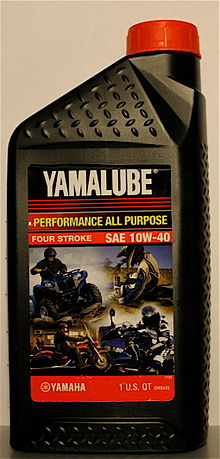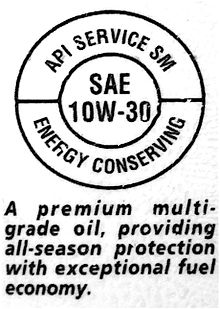- Motorcycle oil
-
Motorcycle Oils are a range of lubricants, including engine oils, which are specifically developed and marketed for use in the internal combustion engines and transmissions of motorcycles and may also be recommended for use in vehicles utilizing drive-trains similar to those of motorcycles, such as quad-bikes.
Details
The vast majority of modern motorcycles use the same oil to lubricate the engine, transmission, and (with the exception of bikes with dry clutches, such as Ducatis, Harley-Davidsons and some BMWs) the clutch. Normal, "car-derived" motor oils are designed just for engines, but were historically suitable in motorcycles. However, some of the latest American Petroleum Institute, or API specifications are claimed to be completely unsuitable for motorcycles with wet clutches, although reports of clutch slippage may be exaggerated. Representative organisations of motorcycle manufactures, particularly Japanese Automotive Standards Organization, or JASO, work with lubricants manufacturers to create "motorcycle-specific" standards for oils, and the relevant oil companies then develop and test oils which are specifically made for motorcycles and in return, they have two different products with the same chemical content.
Transmission lubrication
Motorcycle transmissions, just like all gear-based automotive transmissions can quickly degrade a multi-viscosity, or multi-grade engine oil. Conventional car and truck transmission oils have specific EP, and other specialised anti-wear additives, but these EP additives are not suitable for the combined application of lubricating the engine and transmission with the same oil, as is the norm in motorcycles[citation needed].
Multi-viscosity oils contain viscosity improver chemicals known as VIs that keep the oil from becoming too thin at high temperatures. The VIs are large chemicals that tend to shear between the cogs of a motorcycle transmission. That can have the effect of reducing a 10W-40 oil to a 10W-30 in a relatively short number of miles.
One solution to shearing is to use single weight oils, which do not have VIs and aren't susceptible to degradation in the transmission. However, single weight oils do not flow well in cold conditions, reducing overall lubrication until the oil has warmed up. An alternative is to use a synthetic oil. Synthetic oil are designed to have good cold-flow properties yet maintain high viscosity with fewer VIs.
Clutch lubrication
Many motorcycles have a wet clutch, where the clutch plates are immersed in oil. Some oils make the friction plates in the clutch slippery so that the clutch doesn't engage properly when shifting gears, or the clutch slips when the engine exceeds a certain torque. Some oils contain friction reducing chemicals. One element of the JASO-MA standard is a friction test designed to determine suitability for wet clutch usage. An oil that meets JASO-MA is considered appropriate for wet clutch operations. Oils marketed as motorcycle-specific will carry the JASO-MA label. A properly specified motorcycle oil will still allow for the appropriate lubrication and cooling of a motorcycle clutch, whilst maintaining 100% of the drive to be transmitted by the clutch, even under arduous operating conditions.
Motor fuels Fuel types Fuel additives Butyl rubber • Butylated hydroxytoluene • 1,2-Dibromoethane • 1,2-Dichloroethane • Dimethyl methylphosphonate • 2,4-Dimethyl-6-tert-butylphenol • Dinonylnaphthylsulfonic acid • 2,6-Di-tert-butylphenol • Ecalene • Ethylenediamine • Metal deactivator • Methyl tert-butyl ether • Nitromethane • Tetraethyllead • TetranitromethaneFluids Motor oil • Motorcycle oil • Antifreeze • Automatic transmission fluid • Brake fluid • Gear oil • Windshield washer fluidRetail Categories:- Motorcycle engines
- Motorcycle transmissions
- Petroleum based lubricants
- Motor oils
- Automotive chemicals
Wikimedia Foundation. 2010.


